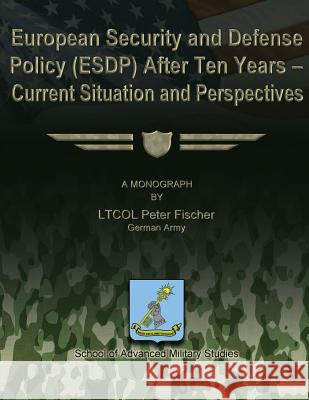European Security and Defense Policy (ESDP) After Ten Years - Current Situation and Perspectives » książka
European Security and Defense Policy (ESDP) After Ten Years - Current Situation and Perspectives
ISBN-13: 9781479286898 / Angielski / Miękka / 2012 / 66 str.
European Security and Defense Policy (ESDP) After Ten Years - Current Situation and Perspectives
ISBN-13: 9781479286898 / Angielski / Miękka / 2012 / 66 str.
(netto: 64,76 VAT: 5%)
Najniższa cena z 30 dni: 68,19
ok. 16-18 dni roboczych
Bez gwarancji dostawy przed świętami
Darmowa dostawa!
After ten years the ESDP has reached an important milestone in its development. It is one of the most dynamic policy areas in the framework of the European Union (EU) and is a substantial integration project. Behind this background the study analyzes the question, What has ESDP achieved in its main fields of action (capabilities, operations/missions and strategic partnership with NATO to include transatlantic relations) to meet the requirements of the European Security Strategy (ESS)? The ESS as the overarching strategic document for the ESDP claims an encompassing security approach and calls to be more capable, more active, more coherent and calls to intensify working with partners. Hence, the ESS together with its implementation report provides the criteria to measure the achievements of the ESDP. In regard to capability development in many respects progress has been made over the last ten years to be more capable. ESDP specifically has built up military and civilian rapid response capabilities (EU Battlegroups and Civilian Response Teams) and the EU has established a European Defense Agency (EDA). However, there is still a lack in military key capabilities and the military reform process in Europe remains slow. Further improvements are necessary focusing on spending money more efficiently and using the EDA to enhance pooling of assets. Operations and missions are the ESDP's figurehead to be more active and to meet the requirement of a global security actor. With twenty-two military operations and civilian missions since 2003 the footprint is considerable. ESDP engagements span almost the globe and cover a wide spectrum (stabilization, rule of law, anti-piracy). Nevertheless, they have been limited in scope and time and the ESDP is still untested in 'high end' operations. A key question for the future is less the number of ESDP engagements but there size, mandate and political ambition. To avoid an overextension of the ESDP clear priorities and regional strategies are needed. With regard to working with partners the current context of the EU - NATO partnership and the underlying transatlantic relations seem more favorable than in the recent years. The United States in principle wants a strong European partner and the ESDP with its civil-military tools is increasingly perceived as added value in a complementary role to NATO for crisis management. There is already close cooperation between EU/ESDP and NATO in the framework of 'Berlin Plus' (Bosnia) or in the way both are working alongside together (Afghanistan, Kosovo). However, despite a more constructive tone between both the unresolved Turkey-Cyprus issue is an obstacle to a true strategic partnership and urgently requires a political solution. In any case, the pull of events, such as Afghanistan, piracy or France's return to NATO's integrated structures, seems to be bringing NATO and the EU/ESDP inexorably closer together. The availability of all instruments - civil and military - makes the ESDP so attractive but coherent and efficient use is necessary. Initiatives to enhance the coherence of institutional structures and the coordination of the ESDP engagements and the EU Commission's activities have been made but they are not yet sufficient. The Lisbon Treaty in force since December 1st, 2009 includes regulations for further improvement of the ESDP and for better coherence but the implementation needs time and results can only be expected gradually. In summary, this study outlines that the ESDP has made significant progress in the main fields of action and has substantially increased the EU's contribution to international security. However, the ESDP is still a process in the making and a lot still needs to be done. Hence, at the threshold of the second decade of the ESDP this ever advancing process continues and will require all the commitment of its stakeholders.
Zawartość książki może nie spełniać oczekiwań – reklamacje nie obejmują treści, która mogła nie być redakcyjnie ani merytorycznie opracowana.











